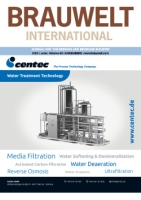Due to their flexibility in configuration and their capacity to be adapted to changed conditions, their efficiency and low space requirements, coupled with a large exchange surface area, plate heat exchangers have become standard process engineering equipment in practically all industrial sectors. Their use in breweries requires particular attention so as to identify risks associated with leaks in a timely fashion.
Continuous separation of spent grains is an important element in developing a continuous brewing process. In the present article, the focus is on technological results, especially in respect of flavour quality in the finished beer.
Production and filling conditions as well as the heat recovery system in the brewhouse must be taken into account in order to arrive at a proper basis for sizing a boiler plant.
The Sapporo Breweries Ltd. (Sapporo) joint venture barley breeding project with Hongri Seeds aims to produce high quality malting barley varieties for specific brewing markets in China and for the Heilongjiang’s barley production region in the northeast of China. Hongri 2 is the latest variety released from the Hongri Seeds Japan-China joint venture company.
Material utilisation of vapour condensate arising from beer wort boiling has been achieved in commercial-scale operations in a number of breweries in recent years. This paper is a review of the state-of-the-art.
This article describes a Keraflux-membrane system for recovery of beer from excess yeast. Its performance capabilities are documented on the basis of statistically evaluated data.
In the following article the author summarises his work on heat transfer in Unitanks. The engineering aspects involved in sizing cooling areas for a Unitank are discussed and the different inputs to be specified by the brewer and the designer, essential to arrive at a satisfactory solution, are listed. The implications of varying the inputs on the final result are explained with illustrations in specific cases. Basic heat transfer equations, theories involved and a stepwise procedure to solve the problem are included. Results from a computer based programme developed for this application are tabulated and the utility of such a model for an optimum solution is explained.
The pivotal role of plate coolers is oftentimes not appreciated, and the associated operating costs related to driver power requirements for supply of refrigeration and reheating energy requirements underestimated. This finding is based on measurements on 56 plate coolers installed in industrial operations. Basics of wort cooling, possibilities for optimisation and sizing examples are presented in this article.
Apart from the established process applications for separators in breweries such as hot wort clarification, beer recovery from excess yeast or beer preclarification ahead of filtration, there are process operations which heretofore were possible only in smaller and medium capacity ranges, such as e.g. cold wort separation or polishing clarification of beer. Westfalia Separator AG has moved high-capacity separation up to another level with the CSA 500 model. While achieving the same separation cut as previous models, the capacity range has been tripled.
In view of the brew cycles required, the lautering process is the bottleneck in production in many plants. Gone are the days when brewing was a bit like concoction of magic potions and mainly a matter of intuition, as was oftentimes the case well into the 19th century. Specifications for process automation in the brewhouse are therefore growing increasingly complex, particularly when controlling a lauter tun bottleneck process.
Besides guaranteeing process safety, brewers have to produce high extract yields and demonstrate great flexibility in terms of raw material quality, variety of recipe and process techniques. Further, process automation seeks to minimise constant personal supervision by brewery staff.
....
Development trials for new boiling systems have shed new light on the issue of foam. The numerous analyses made in the last few years in order to test new technologies have shown that many common assumptions on the topic of foam are difficult to put in practice.
The level of coagulable nitrogen has hitherto been the parameter for good or poor beer foam. However, it should at most be used as an indicator.
A high value for coagulable nitrogen in cast wort is no guarantee of satisfactory foam indices in the finished beer. A low value is just as unlikely to result in poor foam indices. With a coagulable value of 1.3 mg/100 ml in the cast wort, foam indices of over 130 Ross & Clark (R. & C.) can still be obtained. By contrast, coagulable N values of 2. & C. 1 and 2).
....


